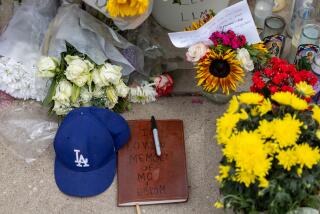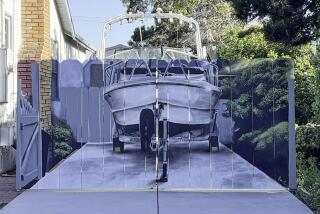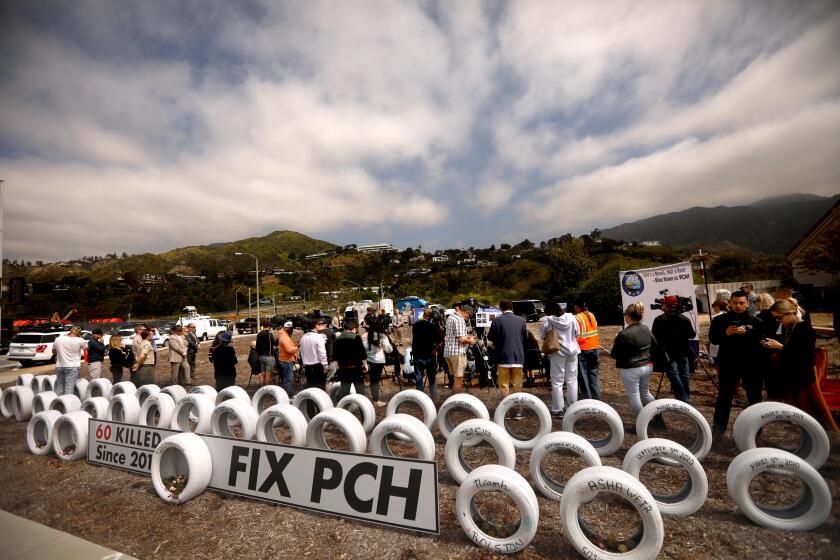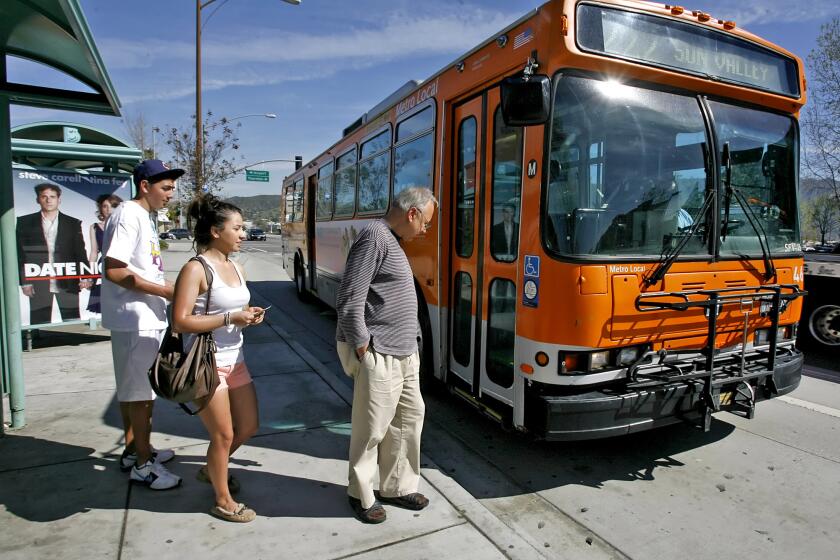Eastside Rail Line Gets Green Light From MTA Board
In a packed and sometimes confrontational meeting, the board of the county’s transit agency cleared the way Thursday for construction of a light rail line that extends from downtown to the Eastside of Los Angeles.
The board of the Metropolitan Transportation Authority blessed the final environmental study for the long-delayed commuter line on an 11-0 vote.
The plan will be sent to the Federal Transit Administration in Washington, which will be asked to affirm its earlier promise to pay for most of the $760-million project.
State money is slated for the rest.
The MTA board approved the rail plan on the same day it gave a double endorsement to faster bus service throughout much of the county.
The agency approved a final environmental review for a much-debated, 14-mile busway across the San Fernando Valley.
It also set in motion plans to roll out 23 new rapid bus lines, adding to two extremely popular existing lines.
But the most contentious issue of the day was the approval of the environmental study for the Eastside rail line.
The study provides a blueprint for the about 6-mile route, which would run from Union Station through Little Tokyo and then east into Boyle Heights, before terminating in unincorporated East Los Angeles.
In Boyle Heights, the line would travel underground for just over a mile, keeping the light rail line off crowded, narrow streets. Construction could begin in the summer of 2003 and be completed in five years.
By passing the plan, the board backed a line regarded as a pet project of Los Angeles County Supervisor and MTA board member Gloria Molina, one of the Eastside’s most powerful politicians.
Molina spearheaded the light rail project after the MTA in 1998 scaled back an old promise to build a subway to the densely packed, transit-dependent Eastside.
“The community is going to be very satisfied with the project we are putting in place,” Molina said Thursday of the line, which will connect with a 13-mile rail segment that is now being built from downtown to Pasadena. “We originally wanted the subway, of course. But after waiting so long, we finally” will have a rail line.
Molina said she expected the Eastside line to be the busiest in the region and a boon to the area’s economy.
Loudly disagreeing with her at Thursday’s meeting was a large, vocal contingent. During the half-hour allotted by the MTA board for public comment, many in the audience of about 350 people blasted Molina and the rail line.
They verbally sparred with the scores of others who support the project and vowed to keep fighting, threatening to appeal to Congress or file lawsuits.
Some critics said the commitment to spend hundreds of millions of dollars on the rail line will make it impossible to fulfill a federal court order to buy more buses to relieve overcrowding.
Others argued that construction would pollute the air and that the underground portion would disturb grave sites at a landmark cemetery. Yet others said they want the entire line to be underground.
But most of the complaints focused on the placement of one of the line’s nine stations.
The stop had long been proposed for a spot 20 yards from El Mercado, a three-story shopping mall and an Eastside landmark.
But planners moved the stop to ensure that firetrucks and other vehicles would have better access. Some saw the move away from the market as a slight.
The plan inflicts “maximum damage to El Mercado,” said Arturo Chayra, a neighborhood activist who organized a petition drive against the rail line. Some El Mercado supporters believe that the rail route would make it harder for automobiles to reach the market’s parking lot, thereby harming the business. To them, the proposal is just the latest by government that would take land from poor Latinos.
The revised plan moves the former El Mercado stop about two blocks east. But that solution raises another set of problems by placing the line on the campus of Ramona High School, a small facility that serves 150 girls. Many of them are teenage mothers, who bring their babies to campus each day.
School Principal Sherry Breskin told board members Thursday that she supports the light rail line.
But she asked the MTA to move the school to a small parcel of land in Boyle Heights that is now the site of an abandoned grocery store.
MTA officials remained noncommittal about their plans for the school, other than to say that they will fund remodeling to make the school habitable on its current lot or move it nearby.
Countering the critics at the meeting was a seemingly equal number of proponents.
They sometimes shouted at the critics, some of them neighbors and longtime friends.
The proponents lavished praise on the plan, noting that there is growing impatience in the community for a rail line--first discussed on the Eastside two decades ago.
Their viewpoint was summed up by Connie Gomez, a grandmother who sat in the audience with a group of about 30 grandparents.
“For us, for our grandchildren, for our businesses, for our connection to the rest of Los Angeles, we want this line,” Gomez said.
“No, we need this line, and we’ve waited long enough.”
More to Read
Start your day right
Sign up for Essential California for news, features and recommendations from the L.A. Times and beyond in your inbox six days a week.
You may occasionally receive promotional content from the Los Angeles Times.







